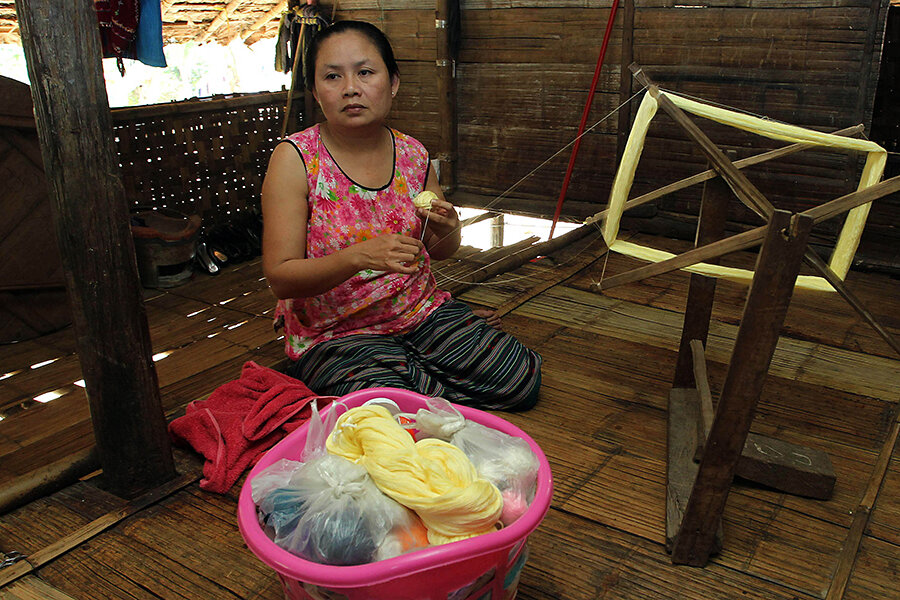As world's support ebbs, Myanmar refugees feel pushed back to unsafe homes
Loading...
| Mae Sot, Thailand
Myanmar’s harsh military rulers were swept aside more than a year ago in a democratic tsunami. A ceasefire was supposed to put an end to decades of civil war between the government and minority ethnic groups. The 100,000 refugees living in camps along the border with Thailand should be rejoicing, one would think.
Instead, they say, they are stranded between a rock and a hard place: the world is telling them to go home – and cutting back on the international aid that has kept them alive – but the Myanmar government has done nothing to help them move back. And the fighting around their villages has not stopped.
“The camps are not our country; we want to go back,” says Saw Kwa Lah Htoo, a young man in his 20s. “But we do not believe there is real peace.”
International aid donors, though, say they now have more pressing priorities than continuing to care for the refugees, most of whom belong to the Karen ethnic group, strung out in nine camps along Thailand’s mountainous border with Myanmar.
“We see much more urgent humanitarian needs in Myanmar than in the camps,” says Pedro-Luis Rojo, regional head of European Civil Protection and Humanitarian Aid Operations (ECHO), once a major funder of refugee care. Last year the group cut its aid by nearly half, from 2.1 million euros ($2.2 million) in 2015 to 1.3 million euros, Mr. Rojo says.
Seventy percent of the Myanmar refugees in Thailand are Karens from southeastern Myanmar; most were forced from their homes by a seven decade-long civil war pitting a variety of ethnic insurgents against the central government.
Win Gat, a refugee in his 70s, is one of them. “I came here because Burmese soldiers came to my house and I could not stay there anymore,” he laments, recalling the brutality of war in a few simple words. “If the soldiers saw villagers, they would kill them. Many died then.”
That was 24 years ago. Ever since, Mr. Win has lived in Mae La, the largest of the border camps, where 42,000 people live fenced in a crowded collection of ramshackle bamboo huts guarded by Thai soldiers.
Today his future is uncertain. Resettlement programs that had found new homes in third countries for 92,000 refugees have ended, according to the UN High Commission for Refugees (UNHCR) office in Bangkok, donors such as ECHO are transferring their activities into Myanmar, and other, newer international crises have arisen to compete for the world’s attention and sympathy.
And life in the camps is growing dire. “We don’t believe that refugee nutrition can be maintained if there are further cuts to the food basket,” warns Duncan McArthur, who runs the Border Consortium (TBC), an organization providing aid to the refugees. Funding cuts have made life increasingly difficult: everything from job skills training to charcoal supplies for cooking has been reduced, Mr. MacArthur says.
But for many refugees, returning home is a daunting prospect too. Among the challenges, admits a UNHCR spokesperson, are physical dangers and inadequate security, difficulties in reclaiming their farmland, and too few jobs.
Top of their list of worries, though, is security. Though the biggest Karen insurgent group, the Karen National Union (KNU), signed a ceasefire with the army in 2015, other rebel groups in the area did not and fighting continues to flare up from time to time.
Last September, clashes reportedly forced almost 4,000 Karen people from their homes, while a recent survey by the Landmines & Cluster Ammunition Monitor found that all seven townships in Karen State are mined. A 2016 study by the Karen Human Rights Group highlighted further problems, ranging from the militarization of villages to land confiscations.
“There is no guarantee of safety and the government of Burma has no plan to receive the refugees yet,” complains Hayso Thako, an official with the Karen Refugee Committee (KRC).
The UNHCR supported a pilot group of 71 refugees returning to Myanmar last October, giving them their travel expenses and about 100 dollars per adult.
The local press, however, soon reported that some of those resettled in Yangon, with no means to pay for their own housing, had found themselves living in a warehouse owned by the Ministry of Social Welfare, Relief and Resettlement.
Pressure on the refugees to leave the border camps “contributes to danger and indignity, not to the safety and dignity that are the international community’s ostensible standard,” warns David Mathieson, a Burma expert who has worked at Human Rights Watch.
“It is incredibly stressful for communities affected by war to be met with such a callous and impatient response by international donors” Mr. Mathieson adds.
Po Yo, a former farmer who has lived in Mae La since 2006, says he knows just what would await him in his home town if he returned there; government troops, the local militias that they have armed and insurgent rebels clash regularly in the surrounding area, he has heard. “The situation in Burma is not good,” Mr. Po says, using Myanmar’s traditional name.
“I cannot go back, there are still Burmese soldiers in my village,” adds Mr. Win, who does not trust the current ceasefire. “I think the KNU and the military will fight again.”





